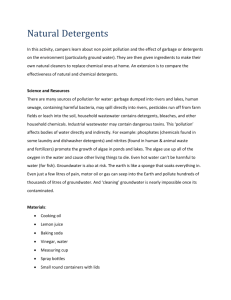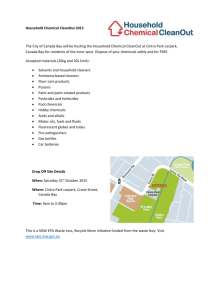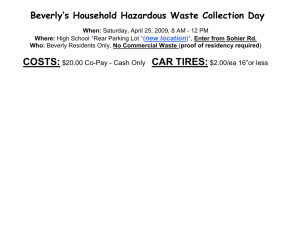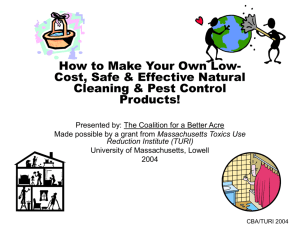file - Toxics Use Reduction Institute
advertisement
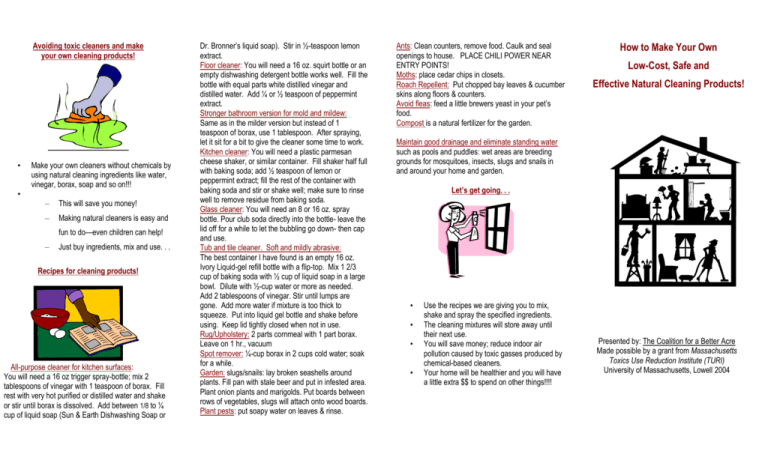
Avoiding toxic cleaners and make your own cleaning products! • Make your own cleaners without chemicals by using natural cleaning ingredients like water, vinegar, borax, soap and so on!!! • – This will save you money! – Making natural cleaners is easy and fun to do—even children can help! – Just buy ingredients, mix and use. . . Recipes for cleaning products! All-purpose cleaner for kitchen surfaces: You will need a 16 oz trigger spray-bottle; mix 2 tablespoons of vinegar with 1 teaspoon of borax. Fill rest with very hot purified or distilled water and shake or stir until borax is dissolved. Add between 1/8 to ¼ cup of liquid soap (Sun & Earth Dishwashing Soap or Dr. Bronner’s liquid soap). Stir in ½-teaspoon lemon extract. Floor cleaner: You will need a 16 oz. squirt bottle or an empty dishwashing detergent bottle works well. Fill the bottle with equal parts white distilled vinegar and distilled water. Add ¼ or ½ teaspoon of peppermint extract. Stronger bathroom version for mold and mildew: Same as in the milder version but instead of 1 teaspoon of borax, use 1 tablespoon. After spraying, let it sit for a bit to give the cleaner some time to work. Kitchen cleaner: You will need a plastic parmesan cheese shaker, or similar container. Fill shaker half full with baking soda; add ½ teaspoon of lemon or peppermint extract; fill the rest of the container with baking soda and stir or shake well; make sure to rinse well to remove residue from baking soda. Glass cleaner: You will need an 8 or 16 oz. spray bottle. Pour club soda directly into the bottle- leave the lid off for a while to let the bubbling go down- then cap and use. Tub and tile cleaner. Soft and mildly abrasive: The best container I have found is an empty 16 oz. Ivory Liquid-gel refill bottle with a flip-top. Mix 1 2/3 cup of baking soda with ½ cup of liquid soap in a large bowl. Dilute with ½-cup water or more as needed. Add 2 tablespoons of vinegar. Stir until lumps are gone. Add more water if mixture is too thick to squeeze. Put into liquid gel bottle and shake before using. Keep lid tightly closed when not in use. Rug/Upholstery: 2 parts cornmeal with 1 part borax. Leave on 1 hr., vacuum Spot remover: ¼-cup borax in 2 cups cold water; soak for a while. Garden: slugs/snails: lay broken seashells around plants. Fill pan with stale beer and put in infested area. Plant onion plants and marigolds. Put boards between rows of vegetables, slugs will attach onto wood boards. Plant pests: put soapy water on leaves & rinse. Ants: Clean counters, remove food. Caulk and seal openings to house. PLACE CHILI POWER NEAR ENTRY POINTS! Moths: place cedar chips in closets. Roach Repellent: Put chopped bay leaves & cucumber skins along floors & counters. Avoid fleas: feed a little brewers yeast in your pet’s food. Compost is a natural fertilizer for the garden. How to Make Your Own Low-Cost, Safe and Effective Natural Cleaning Products! Maintain good drainage and eliminate standing water such as pools and puddles: wet areas are breeding grounds for mosquitoes, insects, slugs and snails in and around your home and garden. Let’s get going. . . • • • • Use the recipes we are giving you to mix, shake and spray the specified ingredients. The cleaning mixtures will store away until their next use. You will save money; reduce indoor air pollution caused by toxic gasses produced by chemical-based cleaners. Your home will be healthier and you will have a little extra $$ to spend on other things!!!! Presented by: The Coalition for a Better Acre Made possible by a grant from Massachusetts Toxics Use Reduction Institute (TURI) University of Massachusetts, Lowell 2004 What’s this all about? What are natural cleaners? How toxic chemicals affect children Read the label and stay away from the following chemicals: What products contain toxic ingredients? • • Since all cleaners, pesticides and other household products contain chemicals and all chemicals are harmful in some way, minimize exposure to chemicals by using all natural products that are cheap, safe and effective. • You will learn how to keep your family, especially your children, safe from harmful chemical exposure in and around your home. • • Knowledge is power • • You will get tips on keeping insects and other pests out of your house by using all natural methods instead of toxic sprays that can be dangerous to your health. You will learn how your body absorbs these chemicals, like lawn chemicals, even when you are not aware of your exposure. Some household chemicals give off gasses that stay in your house, pollute the air, and can be dangerous to our pets and us. CHILDREN ARE MOST AT RISK FOR ILLNESS because: – Put things in their mouths; absorb more toxins because they are growing rapidly-breath faster, eat and drink more for their size. – Children may accidentally drink or eat toxic chemicals. – When they play on the floor or in the dirt, they can inhale and absorb chemicals through their skin and eyes. Chemical exposure may cause allergies, asthma, cancer, developmental/learning disabilities and other diseases and illnesses over the course of their lives. Read Cleaning Labels! Labels are important! Watch for • Oven, toilet, drain cleaners • Solvents • Aerosol spray • Acids • Ammonia • Bleach • Formaldehyde • Butyl cello solve • Lye • Moth balls • Glycols Never mix ammonia and bleach! Toxics in Pesticides (Insect Killers) • Try to eliminate insect problems at the source of the problem by not providing shelter, water or food to pests. – Seal up openings around your house – Remove any food or water sources – Use traps and bait instead of chemicals – If you must use a pesticide, follow label directions! – See ‘garden recipes’ for more tips on keeping insects out of your environment in a natural way! Household Cleaners (this is just a partial list!) Oven, drain, floor, furniture polish, disinfectants, bleach, ammonia, toilet cleaners and more! Garden: insect killers, weed killers, fertilizers, roach and rat poison, flea powder. Paints & Paint Removers Oil based paint, spray paint, varnish, thinners Auto products: Motor oil, brake fluid, fuel, antifreeze, solvents, auto batteries. Products like mothballs, hair dye, nail polish & remover, cosmetics, etc. What health issues can be caused by toxic chemicals? • • • • • • Cancer in adults and children. Problems with fertility (having children.) Problems with childhood development Problems with brain function. Lowers your immune function that fights infection. Causes allergic reaction (rashes, breathing problems.)


